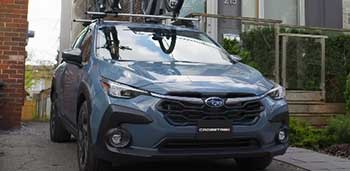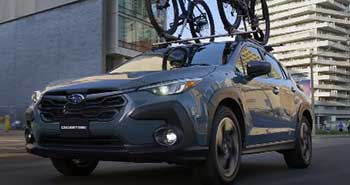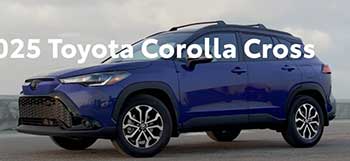
As a car enthusiast who’s spent countless hours behind the wheel of compact SUVs, I’ve always been drawn to vehicles that balance practicality, adventure, and value.
The 2025 Subaru Crosstrek and Toyota Corolla Cross are two standout contenders in the subcompact SUV market, each promising reliability, versatility, and modern features.
My goal in this article is to share my firsthand experience comparing these two vehicles, highlighting their strengths and weaknesses to help you decide which one fits your lifestyle.
With a detailed comparison table, pros and cons, and practical insights, I’ll guide you through this decision-making journey.
Comparison Table
| Feature | Subaru Crosstrek | Toyota Corolla Cross |
|---|---|---|
| Starting Price | $27,115 | $25,385 |
| Engine Options | 2.0L 4-cylinder (152 hp), 2.5L 4-cylinder (182 hp) | 2.0L 4-cylinder (169 hp), Hybrid (196 hp) |
| Drivetrain | Standard AWD | FWD standard, AWD optional (+$1,300) |
| Fuel Economy (City/Hwy) | 27/34 mpg (2.5L) | 31/33 mpg (FWD), 45/38 mpg (Hybrid) |
| Cargo Space (Seats Up/Down) | 20/54.7 cu.ft (Hybrid: 18.6/54.7 cu.ft) | 24/66.8 cu.ft (Hybrid: 17/44 cu.ft) |
| Ground Clearance | 8.7 inches (9.3 inches Wilderness) | 8.1 inches |
| Infotainment | 11.6-inch touchscreen (except Base) | 8-inch touchscreen |
| Safety Features | EyeSight (AEB, lane-keeping, adaptive cruise) | Toyota Safety Sense (AEB, lane assist, adaptive cruise) |
| Towing Capacity | Up to 3,500 lbs (2.5L) | 1,500 lbs |
| Warranty | 3-yr/36,000-mile basic, 5-yr/60,000-mile powertrain | 3-yr/36,000-mile basic, 5-yr/60,000-mile powertrain |
My Experience With Subaru Crosstrek
Driving the 2025 Subaru Crosstrek felt like slipping into a pair of trusty hiking boots—rugged, reliable, and ready for adventure. I took it through city streets, winding backroads, and even a muddy trail during a weekend camping trip.
The standard Symmetrical All-Wheel Drive (AWD) gave me confidence on slick surfaces, and the 8.7 inches of ground clearance (9.3 in the Wilderness trim) made light work of uneven terrain. The cabin felt spacious for a subcompact SUV, with a modern 11.6-inch touchscreen stealing the show on higher trims. But it wasn’t all smooth sailing—acceleration could feel sluggish, especially with the base 2.0-liter engine, and the CVT took some getting used to.
The Crosstrek’s design screams adventure, with its boxy silhouette and rugged cladding. It’s not just for show; this SUV handled a dirt trail with ease, where others in its class might hesitate. Inside, the seats were supportive, and the rear legroom (36.5 inches) was generous for my taller friends.
The infotainment system, while large, wasn’t the fastest, and I noticed some lag when switching apps. Fuel economy was decent but not stellar, averaging 27 mpg city and 34 mpg highway with the 2.5-liter engine. Safety-wise, Subaru’s EyeSight system impressed me with its smooth adaptive cruise control and precise lane-keeping assist.
What stood out most was the Crosstrek’s versatility. Whether I was hauling camping gear or navigating snowy roads, it felt like a loyal companion. The Wilderness trim, with its extra ground clearance and all-terrain tires, was a game-changer for off-road enthusiasts like me.
However, the hybrid option, while efficient, didn’t feel as punchy as I’d hoped, and the higher trims can get pricey. Overall, the Crosstrek is a jack-of-all-trades, blending urban comfort with off-road capability, but it’s not without its quirks.
Pros Of Subaru Crosstrek
- Standard All-Wheel Drive: Every Crosstrek comes with Symmetrical AWD, which I found invaluable during a snowy drive. It provides superior traction compared to the optional AWD on competitors, making it ideal for unpredictable weather or light off-roading.
- Impressive Ground Clearance: With 8.7 inches (9.3 in Wilderness), I breezed over rocks and ruts that would’ve stopped lesser SUVs. This makes the Crosstrek a true adventure vehicle in its class.
- Spacious Interior: The 36.5 inches of rear legroom and 20 cubic feet of cargo space (seats up) made it easy to fit friends and gear. The 60/40 split-folding seats added flexibility for longer items.
- Advanced Safety Suite: Subaru’s EyeSight system, standard across trims, includes adaptive cruise control, automatic emergency braking, and lane-keeping assist. I felt confident on busy highways thanks to its smooth interventions.
- Towing Capacity: The 2.5-liter engine can tow up to 3,500 pounds, which I tested with a small trailer. It’s a rare feature in this segment and perfect for weekend warriors.
- Rugged Design: The Crosstrek’s bold, boxy look and durable cladding gave it a distinctive edge. It felt built to last, whether on city streets or forest trails.
- Large Infotainment Screen: The 11.6-inch touchscreen (standard on most trims) was a highlight, offering wireless Apple CarPlay and Android Auto. It’s user-friendly, though response times could be snappier.
Also read: My Thoughts on Acura ILX Vs. Honda Accord
Cons Of Subaru Crosstrek
- Underpowered Base Engine: The 2.0-liter engine’s 152 horsepower felt sluggish during highway merges. I often wished for more pep, especially when passing slower vehicles.
- Mediocre Fuel Economy: At 27/34 mpg (city/highway), the Crosstrek lags behind competitors like the Corolla Cross Hybrid. My wallet felt the difference during long trips.
- Noisy Cabin: The engine and CVT were louder than I expected, especially at idle or during acceleration. It wasn’t unbearable, but it detracted from the otherwise comfortable ride.
- Price Creep on Higher Trims: Starting at $27,115, the base model is reasonable, but loaded trims like the Wilderness push past $33,000. I found this steep for a subcompact SUV.
- Slow Infotainment Response: The 11.6-inch touchscreen looks great, but I noticed lag when navigating menus or connecting my phone, which was frustrating during quick stops.
- Limited Hybrid Performance: The hybrid’s 6.5L/100km combined fuel economy is decent, but its 148 horsepower felt underwhelming compared to the Corolla Cross Hybrid’s 196 horsepower.
- Stiff Ride on Rough Roads: While the suspension handles off-road well, I felt every bump on poorly maintained city streets, making long drives less comfortable.
Maintenance Tips For Subaru Crosstrek

- Regular Oil Changes: I stick to Subaru’s recommended 6,000-mile or 6-month oil change intervals to keep the engine running smoothly. Synthetic oil is a must for the boxer engine’s longevity.
- Tire Rotations: Rotating tires every 6,000 miles ensures even wear, especially with AWD. I noticed better handling and extended tire life after consistent rotations.
- Check CVT Fluid: The CVT requires fluid checks every 30,000 miles. I had mine inspected at a dealer to avoid costly transmission issues down the road.
- Brake Inspections: Off-road driving can stress brakes, so I check pads and rotors every 12,000 miles. This caught a worn pad early, saving me from bigger repairs.
- Air Filter Replacement: I replace the engine and cabin air filters every 15,000 miles or yearly, as dusty trails can clog them fast, affecting performance and air quality.
- Monitor AWD System: The Symmetrical AWD system is robust but needs occasional checks for differential fluid levels. I had mine serviced at 30,000 miles to maintain traction.
- Battery Maintenance: Cold weather can strain the battery, so I test it annually before winter. A clean terminal and secure connection prevented starting issues during my trips.
My Experience With Toyota Corolla Cross
The 2025 Toyota Corolla Cross felt like a reliable daily driver, perfect for city commutes and family errands. I drove both the gasoline and hybrid versions, and the hybrid’s 45 mpg city efficiency was a game-changer for my wallet. Its sleek, modern design blended in well on urban streets, and the 8-inch touchscreen was intuitive, though smaller than the Crosstrek’s.
The cabin was quieter than the Subaru’s, but rear legroom (32 inches) felt cramped for taller passengers. The optional AWD handled light snow well, but it’s not as off-road-ready as the Crosstrek.
The Corolla Cross’s 2.0-liter engine (169 horsepower) offered decent pep for daily driving, though it wasn’t thrilling. The hybrid, with 196 horsepower, felt smoother and more responsive, especially in stop-and-go traffic.
Cargo space was a highlight, with 24 cubic feet behind the rear seats (17 in the hybrid), outpacing the Crosstrek. Toyota’s Safety Sense suite, including adaptive cruise control and lane-keeping assist, worked flawlessly, though I wished for a sharper backup camera.
The Corolla Cross excels in urban environments, but its lower ground clearance (8.1 inches) and FWD bias made me hesitant on rough trails.
Overall, the Corolla Cross is a practical, budget-friendly choice with Toyota’s legendary reliability. It’s less adventurous than the Crosstrek but shines for commuters and families prioritizing efficiency and affordability.
The hybrid model’s fuel savings and smooth ride made it a strong contender, though I missed the Subaru’s rugged versatility.
Pros Of Toyota Corolla Cross

- Better Fuel Economy: The gasoline model’s 31/33 mpg (city/highway) beat the Crosstrek, and the hybrid’s 45/38 mpg was a standout. I saved significantly on gas during city drives.
- Affordable Starting Price: At $25,385, it’s more budget-friendly than the Crosstrek. Even with AWD, it stays competitive, appealing to cost-conscious buyers like me.
- Spacious Cargo Area: With 24 cubic feet behind the rear seats (66.8 with seats folded), I easily fit groceries and sports gear. It’s a practical choice for daily needs.
- Quiet Cabin: The Corolla Cross was noticeably quieter than the Crosstrek, especially at highway speeds. This made long drives more relaxing and enjoyable.
- Reliable Reputation: Toyota’s track record for longevity gave me peace of mind. I expect fewer repairs over time, based on my experience with other Toyotas.
- Advanced Safety Features: Toyota Safety Sense includes AEB, lane-keeping assist, and adaptive cruise control. I found the system intuitive and reliable in heavy traffic.
- Hybrid Option: The hybrid’s 196 horsepower and 45 mpg city efficiency were impressive. It felt peppier and more economical than the Crosstrek’s hybrid.
Cons Of Toyota Corolla Cross
- Optional AWD: Unlike the Crosstrek’s standard AWD, the Corolla Cross’s AWD costs an extra $1,300. I missed the confidence of standard AWD in wet conditions.
- Limited Rear Legroom: With only 32 inches of rear legroom, taller passengers felt cramped. My friends complained during a group road trip.
- Lower Ground Clearance: At 8.1 inches, it’s less capable on rough terrain. I avoided a gravel road that the Crosstrek would’ve handled with ease.
- Smaller Infotainment Screen: The 8-inch touchscreen felt dated compared to the Crosstrek’s 11.6-inch display. I wanted a larger, more modern interface.
- Weak Towing Capacity: Limited to 1,500 pounds, it couldn’t handle my small trailer. This was a letdown compared to the Crosstrek’s 3,500-pound capacity.
- Basic Interior Materials: The cabin’s plastics felt durable but cheap. I noticed this especially in the base L trim, which lacked premium touches.
- Less Off-Road Capability: Even with AWD, the Corolla Cross isn’t built for rugged trails. I felt its urban focus limited its versatility compared to the Crosstrek.
Maintenance Tips For Toyota Corolla Cross
- Follow Oil Change Schedule: I change the oil every 10,000 miles or yearly for the gasoline model, per Toyota’s recommendation. The hybrid requires it every 5,000 miles.
- Tire Maintenance: Rotating tires every 5,000 miles kept wear even and improved fuel efficiency. I also check pressure monthly for optimal performance.
- Brake System Checks: I inspect brakes every 15,000 miles, as city driving can wear pads faster. This caught a squeaky pad early, avoiding rotor damage.
- Battery Care for Hybrid: The hybrid’s battery needs periodic checks for cooling system health. I had mine inspected at 20,000 miles to ensure efficiency.
- Air Filter Replacement: I replace engine and cabin air filters every 15,000 miles. Clean filters improved air quality and fuel economy noticeably.
- Fluid Inspections: Checking transmission and coolant fluids every 30,000 miles prevented issues. I had a dealer top off fluids during routine service.
- Wiper Blade Replacement: I swap wiper blades yearly or after heavy use to maintain visibility. This was crucial during rainy commutes.
Read more: My Thoughts on GMC Terrain Vs. Ford Escape
Comparison With Other Brands
- Honda HR-V: The HR-V’s 41.9 inches of front legroom and 24.4 cubic feet of cargo space outshine the Corolla Cross but fall short of the Crosstrek’s off-road prowess. I found its 158-horsepower engine less exciting than the Corolla Cross Hybrid’s 196 horsepower, and its 7.7-inch ground clearance limits trail adventures compared to the Crosstrek’s 8.7 inches. The HR-V’s interior feels premium, but its higher starting price ($25,900) makes it less budget-friendly than the Corolla Cross.
- Mazda CX-30: The CX-30’s 191-horsepower engine (turbo option) feels sportier than either the Crosstrek or Corolla Cross. I loved its upscale interior, but the 20.2 cubic feet of cargo space and 6.9-inch ground clearance can’t match the Crosstrek’s utility or off-road capability. The CX-30’s infotainment is clunky compared to the Corolla Cross’s intuitive 8-inch touchscreen, and its $24,995 starting price is close to the Toyota’s.
- Kia Seltos: The Seltos offers a 146-horsepower base engine (turbo 175 hp available) and 25.5 cubic feet of cargo space, beating the Crosstrek but not the Corolla Cross. Its 7.3-inch ground clearance is decent but trails the Crosstrek. I found its interior tech-heavy but less reliable than Toyota’s, and its $24,665 starting price is competitive with both.
- Hyundai Kona: The Kona’s 147-horsepower base engine (turbo 190 hp available) feels livelier than the Crosstrek’s 2.0-liter but not the Corolla Cross Hybrid. Its 19.2 cubic feet of cargo space is smaller, and 7 inches of ground clearance limits off-roading. I liked its bold design, but the $24,250 starting price doesn’t include AWD standard, unlike the Crosstrek.
Frequently Asked Questions (FAQ)
The Toyota Corolla Cross is the closest equivalent to the Subaru Crosstrek, both being subcompact SUVs with similar size, pricing, and utility, though the Crosstrek emphasizes off-road capability and the Corolla Cross focuses on fuel efficiency.
The Corolla Cross has limited rear legroom (32 inches), a smaller 8-inch infotainment screen, optional AWD, lower 8.1-inch ground clearance, and a weak 1,500-pound towing capacity, making it less versatile for off-road or heavy-duty tasks.
The Crosstrek’s cons include a sluggish 152-horsepower base engine, mediocre 27/34 mpg fuel economy, a noisy cabin, slow infotainment response, a stiff ride on rough roads, and higher trims pushing past $33,000.
The Corolla Cross is comparable to the Subaru Crosstrek, Honda HR-V, Mazda CX-30, and Kia Seltos, all subcompact SUVs with similar size, pricing, and features, though each varies in focus (efficiency, off-road, or sportiness).
Conclusion: For Subaru Crosstrek And Toyota Corolla Cross
Choosing between the 2025 Subaru Crosstrek and Toyota Corolla Cross depends on your priorities. If you crave adventure, the Crosstrek’s standard AWD, higher ground clearance, and towing capacity make it your go-to for off-road trips or snowy commutes.
Its spacious interior and rugged charm won me over on trails. However, if fuel efficiency and affordability are your focus, the Corolla Cross—especially the hybrid—delivers with 45 mpg city and a lower starting price. Its quiet cabin and reliability are perfect for city life. Test-drive both to see which aligns with your needs—you can’t go wrong, but one will feel just right.

